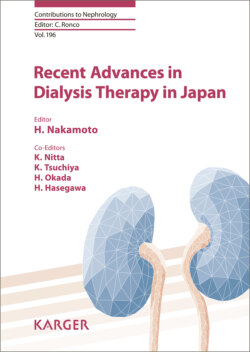Читать книгу Recent Advances in Dialysis Therapy in Japan - Группа авторов - Страница 44
На сайте Литреса книга снята с продажи.
Discussion
ОглавлениеLVH is a common independent risk factor for cardiac death in CKD patients. The prevalence and severity of LVH was increased in parallel with the severity of CKD. Our results showed that plasma ANP is one of the most important risk predictors of LVH [10]. The correlation between plasma ANP and LV mass in this study was comparable with that in previous studies [11]. It has been hypothesized that LA size represents the integration of LV diastolic performance (compliance) over time. Thus, LA volume provides a long-term view of diastolic dysfunction, regardless of the loading conditions and filling pressure present at the time of examination. Studies on nonhypertensive HD patients suggest that LVH may be related to factors such as hyperparathyroidism, sympathetic activity, and pulse wave velocity, because of arterial stiffening and anemia [12–14]. Normalization of Hb (13–14 g/dL) with recombinant human erythropoietin (rHuEpo) treatment did not induce regression of LV dilatation and concentric LVH [12]. On the other hand, treatment of renal anemia with rHuEpo improved cardiac performance and induced regression of LVH in one study [13]. In our study, mean Hb level significantly improved after initiation of HD and was maintained during the observation period. However, it was difficult to improve LVH in HD patients. Comparable BP control between the groups might have reduced the potential development of LVH. In contrast, in patients who did achieve the protocol targets, changes in LVMI were consistent with the findings of previous studies that identified anemia as an independent predictor of LVH [14]. Therefore, there is some evidence that preventing anemia, together with controlling BP and volume status, might favorably affect LV growth among patients with HD. In patients on nocturnal HD, there is a notable reduction in LVMI and LV function [15].
LA size is strongly associated with LVH, and echocardiographic monitoring of LA size has recently emerged as an independent prognostic predictor of cardiovascular risk in patients with CKD. In our study, there was a significant correlation with LA size and LVMI (data not shown). We have recently demonstrated a significant correlation between LA volume index and LVMI in nondiabetic patients [16]. The ectonucleotide pyrophosphatase phosphodiesterase 1 gene – a regulator of insulin sensitivity whose variability has been associated with insulin resistance (IR) in ESKD – is also a relevant factor in the pathogenesis of LVH [17]. We also found that LVMI was larger in diabetic patients than in nondiabetic patients [18].
One study reported that serum phosphorus can stimulate phenotypic transformation of vascular smooth muscle cells into osteoblasts [19]. In our study, the level of serum phosphorus was significantly correlated with LVMI, and 25% of patients were on vitamin D treatment [18]. The B allele of vitamin D receptor gene polymorphism may serve as a marker of altered vitamin D signaling in ESKD patients and was independently related to LVH and LVH progression in ESKD patients [20].
The rate of change of SBP was identified as an independent risk factor for changes in LVMI. Recently, it was reported that systolic arterial hypertension and elevated pulse pressure were closely associated with LVH in predialysis patients. Thus, hypertension has been consistently associated with cardiovascular morbidity and LVH in CKD patients, and the results of our study are consistent with those in the literature. Maintaining low levels of SBP should have beneficial effects on the course of LVH in CKD patients [18].
The rate of change of Hb was identified as an independent risk factor for changes in LVMI. However, recently the Correction of Hemoglobin Outcomes in Renal Insufficiency (CHOIR) study revealed that a targeted Hb level of 13.5 g/dL was more harmful than 11.3 g/dL in predialysis patients with CKD and resulted in no incremental improvement in the quality of life [21]. In addition, the Cardiovascular Risk Reduction by Early Anemia Treatment with Epoetin Beta (CREATE) study showed that in patients with stage 3 or 4 CKD and mild-to-moderate anemia, normalization of Hb levels in the range from 13.0 to 15.0 g/dL did not reduce cardiovascular events when compared with the use of a lower target range (10.5–11.5 g/dL) [22]. Evidence regarding the target value of anemia treatment of CKD patients is not sufficient, especially for the upper limit target value, and more studies are required. Moreover, it is thought that aggressive treatment is needed because the level of Hb did not reach the target value in our study (baseline 10.0 ± 2.2 mg/dL, follow-up period 9.5 ± 2.0 mg/dL). Our study showed that treatment of anemia should prevent LVH and progression of renal dysfunction [23].
Our study has some potential limitations. First is the selection bias associated with the retrospective design, and it was not a double-blinded study. Second, because this is an observational study, it can only establish association but not causal relationship between SBP, Hb, and LVH. Third is uncertainty about averaging 24-h home ambulatory BP monitoring and patient compliance during the use of antihypertensive medication prior to examination. Fourth, we did not perform cardiac magnetic resonance imaging, which, in the past 10 years, has become the new gold standard because of its high precision, reliability, and ability to measure LVMI [24]. This new method will certainly refine the relative role of LVM in the risk assessment of patients with ESKD. Future studies that utilize this method are warranted to assess this.
